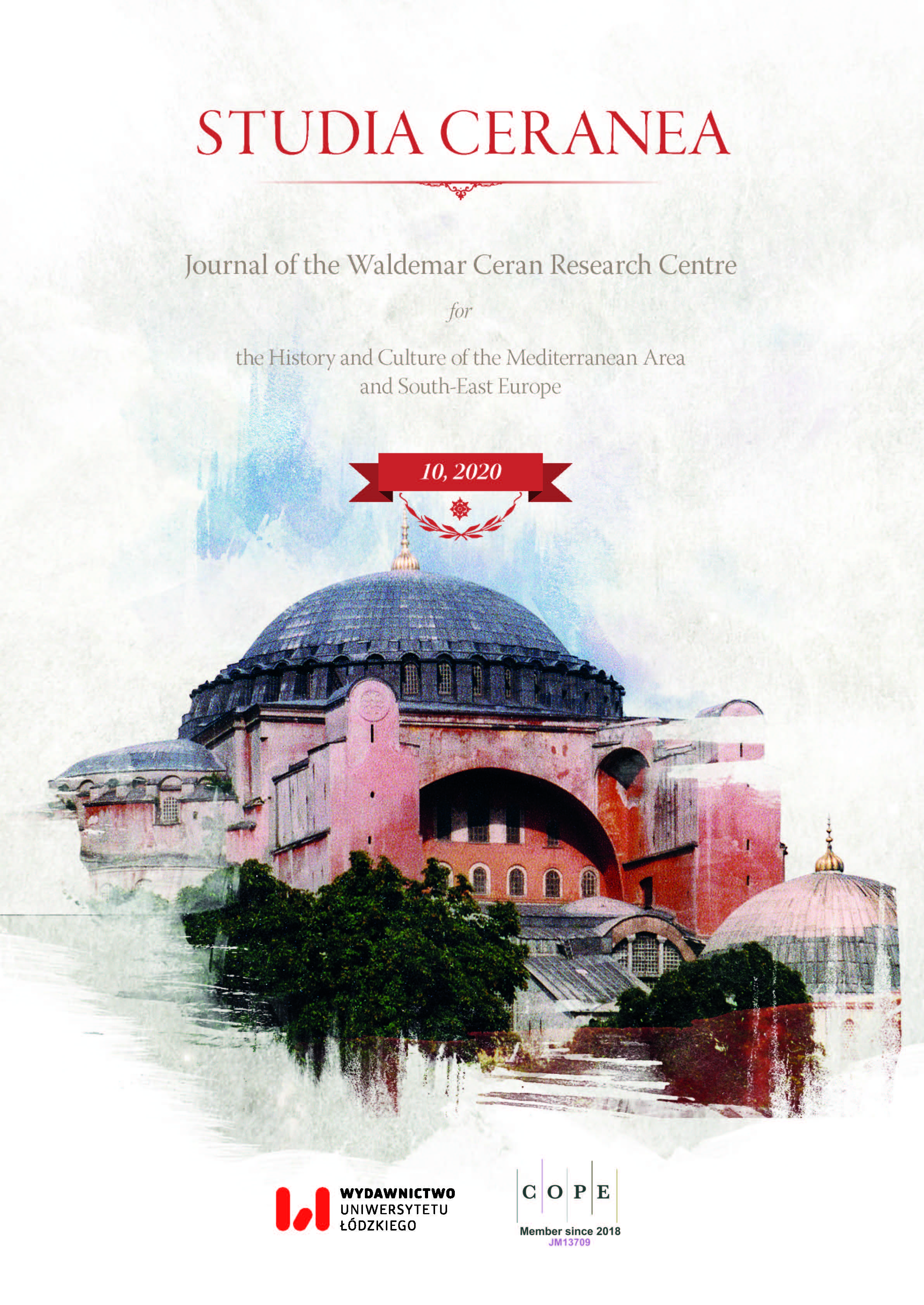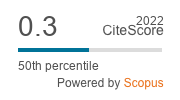The Labarum – from Crux Dissimulata and Chi-Rho to the Open Image Cross
DOI:
https://doi.org/10.18778/2084-140X.10.11Keywords:
labarum, Christ’s cross, Constantine’s vision, church historiographyAbstract
Based on the testimony of emperor Constantine the Great himself, Eusebius of Caesarea presented a labarum in the form of crux dissimulata crowned with the Chi-Rho. The continuers of his Church History in the next century, Rufinus of Aquileia, Philostorgius, Socrates of Constantinople, and Sozomen, only kept the cross-shape of the banner, excluding the christogram. This might have happened because in two main sources informing about the vision of Constantine – the accounts of Eusebius of Caesarea and Lactantius – it was not only the monogram of Christ that played a significant role. The motif of the cross also appears in them, in the account of Eusebius directly, and Lactantius indirectly. Furthermore, Christians interpreted the cross explicitly as a sign of victory. Eusebius wrote about the cross as a symbol of immortality, a triumphant sign of Christ overcoming death. In the account of the bishop of Caesarea, on the other hand, Constantine’s supposed vision included a triumphal sign in the form of a luminous cross, or the symbol of the trophy of salvation. Numismatic evidence also cannot be ignored. Already during the reign of Constantine the Great, the Chi-Rho appeared on the coins both on the shields and on the labarum. However, starting from the reign of Constantius II, coins that were minted included the cross instead of the Chi-Rho on the labarum. It also began to be placed on the shields, in their central part, where the monogram of Christ used to be. Over time, the cross replaced the entire labarum. The iconography present on the coins may prove that the phenomenon of identifying the labarum or Chi-Rho with the cross was not limited to church historiography and was more widespread, although it should be remembered that coins continued to also be decorated with the letters Chi-Rho. Therefore, the representation of the cross did not replace this symbol. However, it cannot be ruled out that the increasingly common image of the cross on coins also contributed to the aforementioned perception of the labarum by church historians.
Downloads
References
Eusebius, Vita Constantini, ed. F. Winkelmann, Berlin–New York 2008.
Google Scholar
In Praise of Later Roman Emperors. The Panegyrici Latini, ed. et trans. R.A.B. Mynors, C.E.V. Nixon, B.S. Rodgers, Berkeley–Los Angeles–Oxford 1994.
Google Scholar
Iustinus, I Apologia, [in:] Justin, Philosopher and Martyr, Apologies, ed. D. Minns, P. Parvis, Oxford 2009 [= Oxford Early Christian Texts].
Google Scholar
Lactantius, De mortibus persecutorum, ed. J. Moreau, Paris 1954 [= Sources chrétiennes, 39].
Google Scholar
Philostorgius, Kirchengeschichte, ed. I. Bidez, F. Winkelmann, Berlin 1981 [= Die griechischen christlichen Schriftsteller der ersten [drei] Jahrhunderte].
Google Scholar
Rufinus Aquileiensis, Historia Ecclesiastica, ed. E. Schwartz, T. Mommsen, F. Winkelmann, Berlin 1999.
Google Scholar
Socrates, Kirchengeschichte, ed. G.C. Hansen, Berlin 1995 [= Die griechischen christlichen Schriftsteller der ersten [drei] Jahrhunderte. Neue Folge, 1].
Google Scholar
Sozomenus, Kirchengeschichte, ed. J. Bidez, G.C. Hansen, Berlin 1995 [= Die griechischen christlichen Schriftsteller der ersten [drei] Jahrhunderte. Neue Folge, 4].
Google Scholar
Alföldi A., The Conversion of Constantine and Pagan Rome, trans. H. Mattingly, Oxford 1969.
Google Scholar
Bardill J., Constantine, Divine Emperor of the Christian Golden Age, Cambridge 2011.
Google Scholar
Barnes T.D., Constantine and Eusebius, Cambridge Mass.–London 1981.
Google Scholar
Barnes T.D., The Conversion of Constantine, “Échos du monde classique” 29, 1985, p. 371–391.
Google Scholar
Barnes T.D., Lactantius and Constantine, “Journal of Roman Studies” 63, 1973, p. 29–46, https://doi.org/10.2307/299163
Google Scholar
DOI: https://doi.org/10.2307/299163
Baynes N.H., Constantine the Great and the Christian Church, London 1934.
Google Scholar
Bidez J., A propos d’une biographie nouvelle de l’empereur Constantin, “L’antiquité classique” 1, 1932, p. 1–7, https://doi.org/10.3406/antiq.1932.2934
Google Scholar
DOI: https://doi.org/10.3406/antiq.1932.2934
Bremmer J.N., The Vision of Constantine, [in:] Land of Dreams. Greek and Latin Studies in Honour of A.H.M. Kessels, ed. A.P.M.H. Lardinois, M.G.M. van der Poel, V.J.C. Hunink, Leiden 2006, p. 57–79.
Google Scholar
DOI: https://doi.org/10.1163/9789047409281_009
Chadwick H., The Early Church, London 1967.
Google Scholar
Chico D.M., Sánchez F.L., Une nouvelle variété de solidus au nom de Constance II avec le chrisme à l’intérieur du bouclier, “Bulletin de la Société française de numismatique” 71, 2016, p. 138–141.
Google Scholar
Daniélou J., Histoire des doctrines chrétiennes avant Nicée. Théologie du judéo-christianisme, Paris 1991.
Google Scholar
Desroches M., Le Labarum, Paris 1894.
Google Scholar
Dimaio M., Zeuge J., Zotov N., Ambiguitas Constantiniana: The Caeleste Signum Dei of Constantine the Great, “Byzantion. Revue internationale des études byzantines” 58, 1988, p. 333–360.
Google Scholar
Drake H.A., Constantine and the Bishops. The Politics of Intolerance, Baltimore 2000 [= Ancient Society and History].
Google Scholar
Drijvers J.W., The Power of the Cross – Celestial Cross Appearances in the Fourth Century, [in:] The Power of Religion in Late Antiquity, ed. A. Cain, N. Lenski, Farnham 2009, p. 237–248.
Google Scholar
Egger R., Das Labarum, die Kaiserstandarte der Spätantike, Wien 1960.
Google Scholar
Gagé J., Le signum astrologique de Constantin et le millenarisme de Roma aeterna, “Revue d’histoire et de philosophie religieuses” 31, 1951, p. 181–223, https://doi.org/10.3406/rhpr.1951.3267
Google Scholar
DOI: https://doi.org/10.3406/rhpr.1951.3267
Girardet K.M., Konstantin und das Christentum: die Jahre des Entscheidung, 310 bis 314, [in:] Konstantin der Grosse. Geschichte – Archäologie – Rezeption. Internationales Kolloquium vom 10.–15. Oktober 2005 an der Universität Trier zur Landesausstellung Rheinland-Pfalz “Konstantin der Grosse”, ed. A. Demandt, J. Engemann, Trier 2006, p. 69–80.
Google Scholar
Grégoire H., La „conversion” de Constantin, “Revue de l’Université de Bruxelles” 36, 1930/1931, p. 231–272.
Google Scholar
Grégoire H., La vision de Constantin «liquidée», “Byzantion. Revue internationale des études byzantines” 14, 1939, p. 341–351.
Google Scholar
Hatt J.-J., La vision de Constantin au sanctuaire de Grand et l’origine celtique du labarum, “Comptes rendus des séances de l’année de l’Académie des inscriptions et belles-lettres” 1, 1950, p. 83–86, https://doi.org/10.3406/crai.1950.78500
Google Scholar
DOI: https://doi.org/10.3406/crai.1950.78500
Heiland F., Die astronomische Deutung der Vision Konstantins, Jena 1948.
Google Scholar
Janiszewski P., Żywioły w służbie propagandy, czyli po czyjej stronie stoi Bóg. Studium klęsk i rzadkich fenomenów przyrodniczych u historyków Kościoła w IV i V wieku, [in:] Chrześcijaństwo u schyłku starożytności. Studia źródłoznawcze, vol. III, ed. T. Derda, E. Wipszycka, Kraków 2000, p. 11–190.
Google Scholar
Jones A.H.M., Constantine and the Conversion of Europe, Harmondsworth 1972.
Google Scholar
Keresztes P., The Phenomenon of Constantine the Great’s Conversion, “Augustinianum” 27, 1987, p. 85–100, https://doi.org/10.5840/agstm1987271/28
Google Scholar
DOI: https://doi.org/10.5840/agstm1987271/28
Kolb F., Ideał późnoantycznego władcy. Ideologia i autoprezentacja, trans. A. Gierlińska, Poznań 2008.
Google Scholar
Lenski N., Constantine and the Cities. Imperial Authority and Civic Politics, Philadelphia 2016 [= Empire and After], https://doi.org/10.9783/9780812292237
Google Scholar
DOI: https://doi.org/10.9783/9780812292237
Lenski N., The Reign of Constantine, [in:] The Cambridge Companion to Age of Constantine, ed. N. Lenski, Cambridge 2006, p. 59–90, https://doi.org/10.1017/CCOL0521818389.004
Google Scholar
DOI: https://doi.org/10.1017/CCOL0521818389.004
Liebeschuetz J.H.W.G., Barbarians and Bishops. Army, Church, and State in the Age of Arcadius and Chrysostom, Oxford 1992.
Google Scholar
Liftin B.M., Eusebius on Constantine: Truth and Hagiography at the Milvian Bridge, “Journal of the Evangelical Theological Society” 55.4, 2012, p. 773–792.
Google Scholar
Long J., How to Read a Halo. Three (or More) Versions of Constantine’s Vision, [in:] The Power of Religion in Late Antiquity, ed. A. Cain, N. Lenski, Farnham 2009, p. 227–235.
Google Scholar
Łukaszewicz A., A propos du symbolisme impérial romain au IVe siècle: Quelques remarques sur le christogramme, “Historia. Zeitschrift für alte Geschichte” 39.4, 1990, p. 504–506.
Google Scholar
MacCormack S.G., Art and Ceremony in Late Antiquity, Berkeley–Los Angeles–London 1981.
Google Scholar
MacMullen R., Constantine and the Miraculous, “Greek, Roman, and Byzantine Studies” 9, 1968, p. 81–96.
Google Scholar
Maraval P., La religion de Constantin, “Anuario de Historia de la Iglesia” 22, 2013, p. 17–35.
Google Scholar
Marcone A., Pagano e cristiano. Vita e mito di Costantino, Roma–Bari 2002.
Google Scholar
Müller-Rettig B., Der Panegyricus des Jahres 310 auf Konstantin den Großen. Übersetzung und historisch-philologischer Kommentar, Stuttgart 1990.
Google Scholar
Nicholson O., Constantine’s Vision of the Cross, “Vigiliae christianae” 54, 2000, p. 309–323, https://doi.org/10.1163/157007200X00189
Google Scholar
DOI: https://doi.org/10.1163/157007200X00189
Odahl C.M., The Celestial Sign on Constantine’s Shields at the Battle of the Mulvian Bridge, “Journal of the Rocky Mountain Medieval and Renaissance Association” 2, 1981, p. 15–28.
Google Scholar
Odahl C.M., Christian Symbols in Military Motifs on Constantine’s Coinage, “SAN: Journal of the Society for Ancient Numismatics” 13.4, 1983, p. 64–72.
Google Scholar
Odahl C.M., Christian Symbols on Constantine’s Siscia Helmet Coins, “SAN: Journal of the Society for Ancient Numismatics” 8.4, 1977, p. 56–58.
Google Scholar
Odahl C.M., Constantine and the Christian Empire, London–New York 2004, https://doi.org/10.4324/9780203449950
Google Scholar
DOI: https://doi.org/10.4324/9780203449950
Piganiol A., L’Empereur Constantin, Paris 1932.
Google Scholar
The Roman Imperial Coinage, vol. VII, Constantine and Licinius A.D. 313–337, ed. P.M. Bruun, London 1966.
Google Scholar
The Roman Imperial Coinage, vol. VIII, The Family of Constantine I, ed. J.P.C. Kent, London 1981.
Google Scholar
The Roman Imperial Coinage, vol. X, The Divided Empire and the Fall of the Western Parts AD 395–491, ed. J.P.C. Kent, London 1994.
Google Scholar
Seston W., La vision païenne de 310 et les origines du chrisme constantinien, “Annuaire de l’Institut de philologie et d’histoire orientales et slaves”, Mélanges F. Cumont 4, 1936, p. 373–395.
Google Scholar
Singor H., The Labarum, Shield Blazons and Constantine’s Caeleste Signum, [in:] The Representation and Perception of Roman Imperial Power, ed. L. Blois, Amsterdam 2003, p. 481–500, https://doi.org/10.1163/9789004401631_037
Google Scholar
DOI: https://doi.org/10.1163/9789004401631_037
Toom T., Constantine’s Summus Deus and the Nicene Unus Deus: Imperial Agenda and Ecclesiastical Conviction, “Vox Patrum. Antyk Chrześcijański” 34, 2014, p.103–122.
Google Scholar
DOI: https://doi.org/10.31743/vp.3612
Van Dam R., The Many Conversions of the Emperor Constantine, [in:] Conversion in Late Antiquity and the Early Middle Ages. Seeing and Believing, ed. K. Mills, A. Grafton, Rochester 2003, p. 127–151.
Google Scholar
Weiss P., The Vision of Constantine, “Journal of Roman Archaeology” 16, 2003, p. 237–259, https://doi.org/10.1017/S1047759400013088
Google Scholar
DOI: https://doi.org/10.1017/S1047759400013088
Westermark U., A New Silver Medallion of Constantius II, “Nordisk numismatisk årsskrift”, 1968, p. 5–10.
Google Scholar
Williams J., Religion and Roman Coins, [in:] A Companion to Roman Religion, ed. J. Rüpke, London 2007, p. 143–163, https://doi.org/10.1002/9780470690970.ch11
Google Scholar
DOI: https://doi.org/10.1002/9780470690970.ch11
Woods D., Eusebius, VC 4.21, and the Notitia Dignitatum, [in:] Studia patristica 29, 1997, p. 195–202.
Google Scholar
Ziółkowski A., Wizja Konstantyna. Reinterpretacja, “Vox Patrum. Antyk Chrześcijański” 4, 1983, p. 200–215.
Google Scholar
DOI: https://doi.org/10.31743/vp.10291
Downloads
Published
How to Cite
Issue
Section
License

This work is licensed under a Creative Commons Attribution-NonCommercial-NoDerivatives 4.0 International License.













